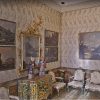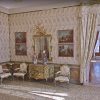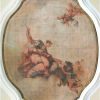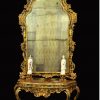The room known as the Green Lacquer Room is one of the most enchanting rooms in the palace. It takes its name from the emerald green lacquered furniture from Palazzo Calbo Crotta at Canneregio, with its decorative elements in gilded pastiglia (that is, a kind of stucco made with plaster and marble dust).
Over the centuries, the fanciful accounts of travellers had caused a decidedly unreal view of China and more generally of the whole orient to be spread over Europe; it was seen as an imaginary land populated by inhabitants with improbable customs. In the figurative arts, interest in the marvellous Cathay had already materialised in the 17th century at the court of Louis XIV, but it was in the following century that it became a real fad infecting all aspects of the figurative arts. In fact there are many elements of far eastern art which coincide with rococo art: asymmetry, lightness, absence of shading and perspective.
Eastern and European motifs thus merged to form an independent new style which, it should be specified, was wholly western: this style was known as chinoiserie. Decorative motifs from oriental prototypes were applied to western forms and types, as in the furniture here. Its exquisite, sinuous Louis XV forms are however decorated with narrative scenes full of exotic motifs. Pagodas, umbrellas, willows, cherry-trees and gold oriental figurines flutter along the green lacquer background, framed within rococo ornamental motifs. The small Chinese polychrome figures in terracotta with moving heads are in fact original oriental pieces.
On the ceiling is the fine Triumph of Diana by Antonio Guardi, coming from Palazzo Barbarigo Dabalà and datable to the 1760s. Diana, seated on a cloud and surrounded by cherubs, is holding a spear in her right hand, while two cupids are playing with a dog at her feet. Unlike his younger brother Francesco, Antonio Guardi never ventured into view painting, but remained a prolific figure painter throughout his not very successful career. In his latest works, which include the frescoes in this and the next room, he showed himself to be one of the most lyrical exponents of Venetian rococo, creating compositions with a vibrant interplay of loose, frayed brushstrokes, and transforming the figures into diaphanous silhouettes which dissolve into the light.




